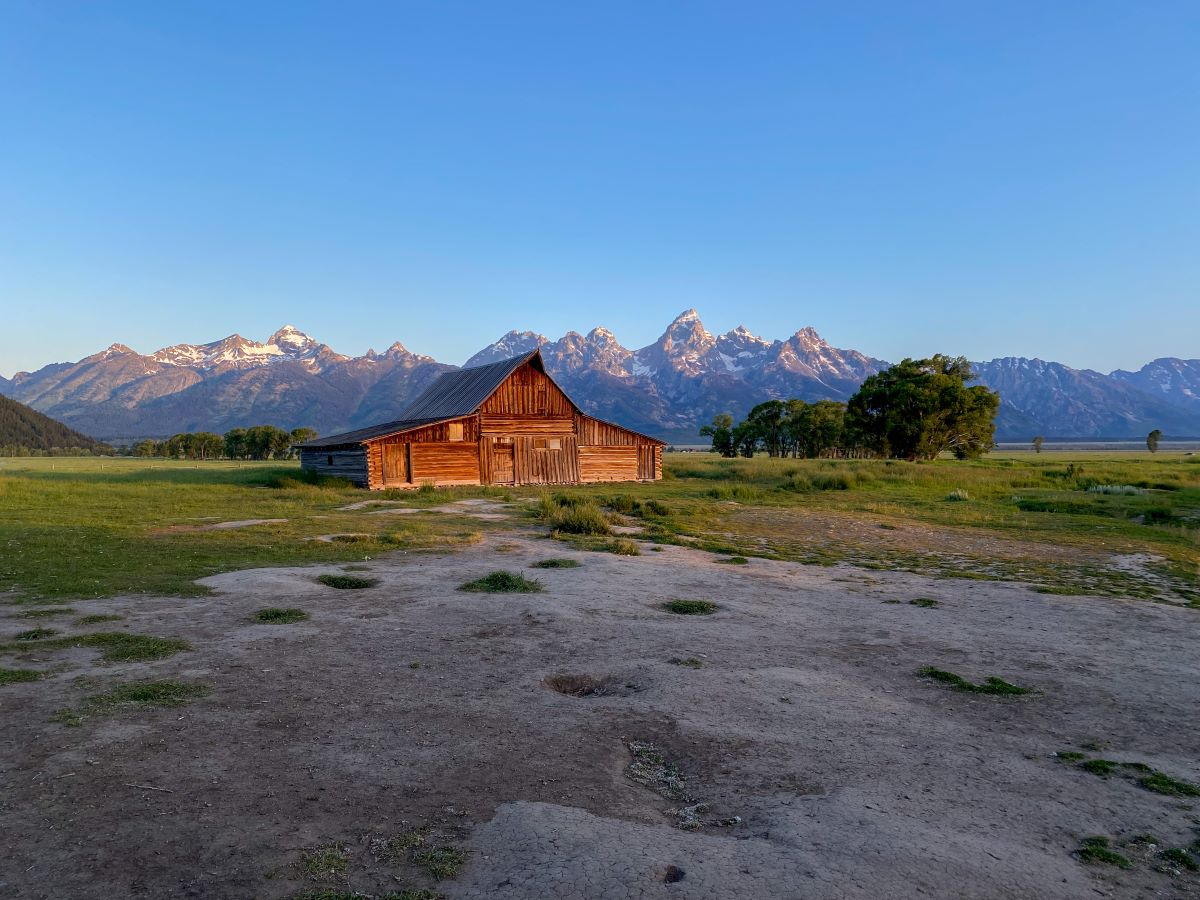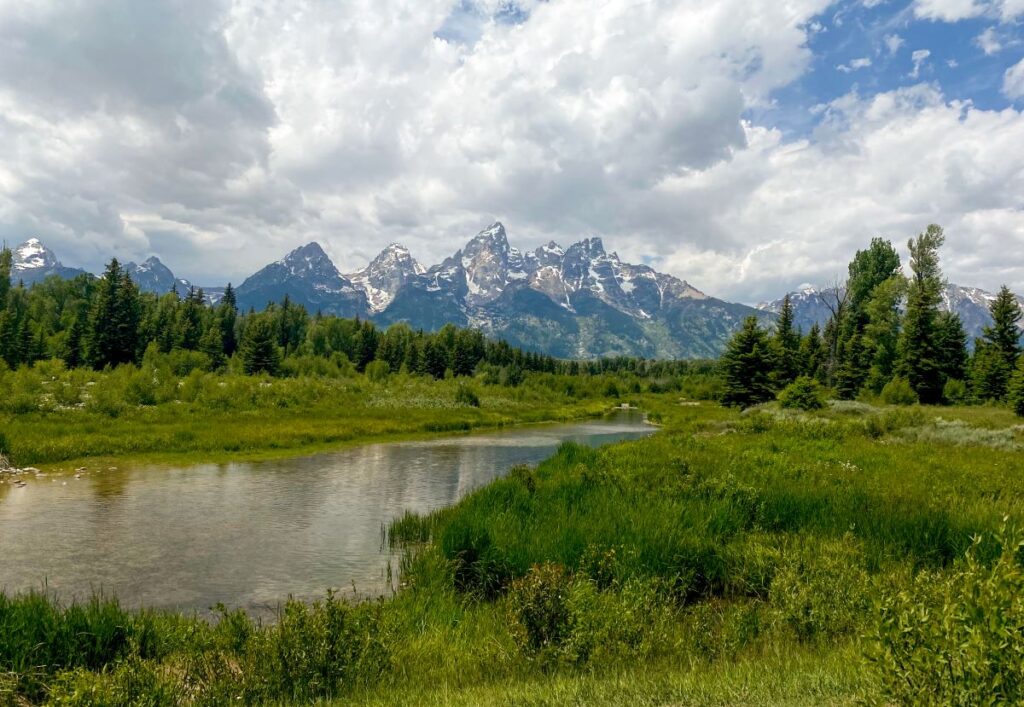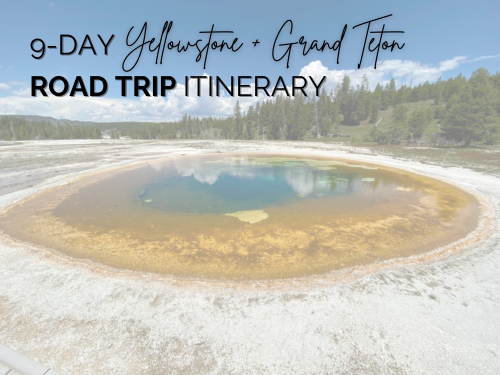
Grand Teton National Park
Grand Teton National Park is a long and narrow park that runs north-south along the Teton Mountain Range in northwest Wyoming. It is located just 30 minutes south of Yellowstone National Park.
The Teton Mountain Range contains some of the oldest rocks in the world. They are a fault block mountain range, carved from a segment of the Earth’s crust that has been pushed up on a fault line. Add in some glacier activity and erosion, and you have the famous, rugged Grand Tetons that we know today.
Along with the rugged mountain peaks, Grand Teton National Park is also known for its abundant wildlife and gorgeous alpine lakes. There are a ton of incredible hiking, backpacking, and photography opportunities here.
Grand Teton Facts
Annual Visitors: 3.4 million in 2023
Size: 310,000 acres
Location: Wyoming
Year Founded: February 26, 1929
Entrance Fee: $35
Reservations Required?: No

Best Things to Do in Grand Teton
MORMON ROW: Explore and learn about the history of the famous Moulton Barns at Mormon Row. These barns were built by T.A. Moulton and his family in the early 1900’s. They remain one of the most photographed locations in Grand Teton National Park, and are most famous for sunrise photography.
HIDDEN FALLS & INSPIRATION POINT: The most popular thing to do at Grand Teton National Park is to hike to Hidden Falls and Inspiration Point. Tucked into the base of the Tetons across Jenny Lake, this short but steep hike rewards you with panoramic views across Jenny Lake and a visit to an impressive waterfall.
42-MILE SCENIC DRIVE: The 42-mile scenic drive is made up of Teton Park Road (the inner road) and US Highway 26/89/191 (the outer road). There are junctions to enter the loop at Moose, Moran, and Jackson Lake. This is a great way to experience the incredible scenery at Grand Teton National Park.
JENNY LAKE: Jenny Lake is one of the most picturesque lakes in Grand Teton National Park. Go for a 7-mile hike around the lake, go kayaking or canoeing on the Lake, or do the Jenny Lake Scenic Drive.
WILDLIFE SPOTTING: Grand Teton National Park is home to a ton of amazing wildlife, including moose, elk, bison, bear, river otters, pronghorn, and more. Oxbow Bend, Antelope Flats Road, and Moose-Wilson Road are some of the best places to see wildlife. Go early in the morning or in the evening when the animals are most active for the best chance at viewing wildlife!
TAGGART & BRADLEY LAKES: The Taggart and Bradley Lake Loop trail is a 6-mile moderate hike to 2 gorgeous lakes in the Teton Range. You’ll enjoy incredible views of Grand Teton, the park’s tallest peak! You hike to each lake separately, but the trails connect so it often makes sense to hike them as a loop.
SIGNAL MOUNTAIN: Signal Mountain is a narrow, winding road up 800 feet to an overlook of the Teton Mountains, Jackson Lake, and the Jackson Hole Valley. This road is not suited for RVs or trailers and closes in the winter.
SCHWABACHER LANDING: Schwabacher Landing is a great place to see the reflection of the Teton mountains in the water. There is an easy 0.5-mile hike along the river and the scenery is just stunning!
CASCADE CANYON: Cascade Canyon is located behind Inspiration Point at the base of the Tetons. You’ll want to take the Jenny Lake boat shuttle across the lake, hike to Inspiration Point, and then continue back into Cascade Canyon. The entire hike is over 9 miles, but you can hike just 20-30 minutes into the canyon for fantastic views of the mountain peaks.
STRING & LEIGH LAKES: The String and Leigh Lakes are two small lakes situated just north of Jenny Lake. There are a few short, easy trails here that follow the lake and it can be a nice way to spend an hour or two in Grand Teton National Park. This is also a great spot to kayak, canoe, or paddleboard, but you’ll have to bring your own boat as there are no rentals here.
HIKING: There is no shortage of incredible hiking opportunities in Grand Teton National Park. Check out the best easy hikes in Grand Teton or hike a more strenuous trail. Phelps Lake, Death Canyon, or the Paintbrush Canyon + Cascade Canyon Loop are all excellent choices. Bring plenty of food, water, and bear spray!
EXPLORE JACKSON HOLE: Jackson Hole is a great little town with a lot of restaurants, shops, and museums to explore. Get your photo in front of the famous antler arches in the town square, visit the Million Dollar Cowboy Bar, or check out the National Museum of Wildlife Art.
When to Visit
The best time to visit Grand Teton National Park is in the late summer through early fall. You’ll avoid the summer crowds, still have nice weather, and start to see some fall colors.
Summer brings perfect weather, but be prepared for more crowds. Even though it doesn’t get as many visitors as its super-popular neighbor, Yellowstone, Grand Teton National Park is still an incredibly popular summer destination. You can still have a pleasant experience in the summer, it just takes a bit more planning and starting early to beat the crowds.
You’ll also see snow on the Teton peaks through mid-July (I think the snow makes for better photos!).
Grand Teton National Park is open year-round, but Teton Park Road closes to cars during the winter due to snowfall. You can still visit during the winter, but you won’t be able to get to Jenny Lake and many other places on the 42-Mile Scenic Drive unless you want to cross-country ski it!
How Many Days Do You Need?
If you don’t like hiking, you really only need 1 day in Grand Teton National Park. If you do enjoy hiking, spending 2-3 days or more will give you time to see the highlights and hike some of the best trails. 2-3 days also allows you to catch a few of the famous Grand Teton sunrises at the most popular viewpoints.
There are some incredible long trails here that will take you a full day to hike, so add one day per long trail you plan to hike. You could easily spend an entire week just hiking here.
How to Get There
Grand Teton National Park is situated just south of Yellowstone National Park and north of the Jackson Hole Valley. The easiest way to get here is to fly into the Jackson Hole Airport and rent a car.
If you’re combining your Grand Teton National Park itinerary with a trip to Yellowstone as well, you might also consider flying into Bozeman or Billings, exploring Yellowstone, and then driving south to Grand Teton.
Salt Lake City can also be a more affordable airport to fly into, but it will take almost 5 hours to drive to Grand Teton National Park. If you can spare the extra vacation time, the cost savings might be worth it to you.
The main road through Grand Teton National Park is US Highway 191/26/89 (three highways share this road but it’s only one road) and follows the Teton Range and Snake River north to south. Teton Park Road spurs off the main highway at the Moose and Jackson Lake junctions and runs parallel to the main highway.
Teton Park Road takes you to a lot of the main attractions in the park, like Jenny Lake, Signal Mountain, and Jackson Lake.
Grand Teton National Park Map

Where to Stay
The best place to stay when visiting Grand Teton National Park is Jackson, Wyoming.
There are quite a few in-park lodges at Grand Teton National Park, but they are really expensive and don’t have many included amenities.
Jackson is only a 15 minute drive from Moose and a 30 minute drive to Jenny Lake. Jackson also has a ton of hotels and restaurants to choose from as well, which can make for a better stay!
Here are some highly rated places to stay in Jackson:
- ELK REFUGE INN: Clean, simple, budget-friendly hotel located just north of Jackson. This is where we stayed and we enjoyed it!
- THE LODGE AT JACKSON HOLE: Mid-range accommodations just 1 mile from the Jackson Town Square.
- HOTEL JACKSON: Upscale hotel in the heart of downtown Jackson.
Grand Teton Road TRIP IDEAS
Spend 9 days road tripping through Yellowstone and Grand Teton National Parks. This is a great trip to do if you have 5 days of PTO + 2 weekends to spend. You’ll spend 5 days visiting multiple locations in Yellowstone and 3 days exploring the Grand Tetons.





